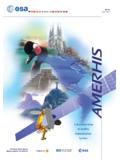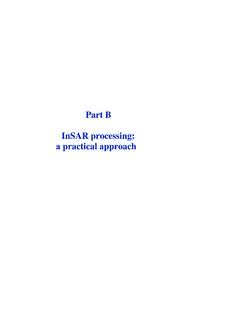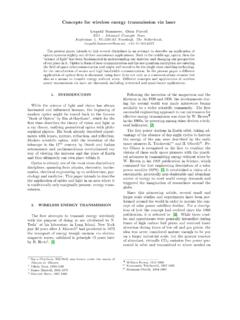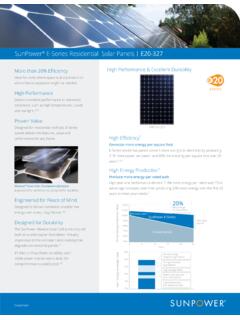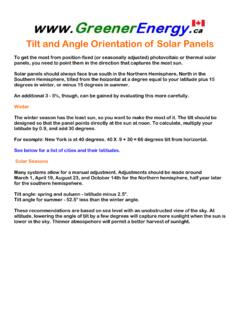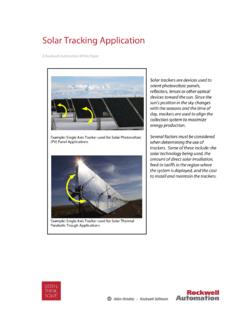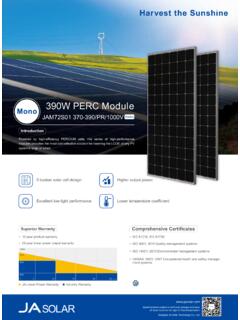Transcription of Satellite Power Systems
1 TECHNOLOGY PROGRAMMESS atellite Power SystemsSolar energy used in spaceBR-202 May 2003 TECHNOLOGY PROGRAMMESINTRODUCTIONThe success of a space mission is always linked to theperformance of technology. To have a technology ready when asatellite flies, research and development must start years inadvance. This is the objective of the Technology Programmes ofthe European Space Agency: to ensure effective preparation forEuropean space cells are a good example of space technology. Thisbrochure gives you many examples of how they work on aspacecraft, and what challenges they must hope it will let you share the enthusiasm of the engineers whowrote the stories. Above all, I hope it will help you to appreciatethe efforts of all those European engineers who work behind thescenes on space projects, not only in the area of solar cells, butalso in many other fields.
2 Without their hard work, Europe ssuccess in space would not have been E. JensenHead of the Technology Programmes DepartmentNothing can change its state or position withoutenergy. Just like many other machines, satellitesalso need electrical Power to powerEvery life form or machine needs energy to function When one is out in space, however, the problem is where to get thatpower from. Here on the ground there are many ways to produceelectrical Power - or rather to transform some other form of energyinto electricity. If you are at sea or on top of a mountain, for example,you can use portable generators or Sun is a very powerful, clean and convenient source of Power ,particularly for satellites. The only thing needed is a means toconvert the energy contained in the Sun s radiation mainly lightand ultraviolet rays into electrical Power .
3 The most efficient way toachieve this today is by using panels composed of semiconductorphotovoltaic cells. solar panels , as they are usually called, are nowquite a common sight here on Earth, but they were first used inspace in 1958 to Power the Vanguard Sun is a very powerful, clean and convenient source of Power , particularly for satellitesSATELLITE Power SYSTEMSHow do solar cells work?Each one of the thousands photovoltaic cells to befound in a solar panel is made of a semiconductormaterial, mostly silicon, capable of converting thelight arriving from the Sun into an electrical is exactly the reverse of what happens in any ofthe thousands light-emitting diodes (LEDs) to befound on the front panels of almost all of today s electronic silicon are rather strange are normally insulators, which means that an electriccurrent cannot pass through them, but it is possible tochange crystals made of these materials into conductorsby applying a sufficiently high voltage to them.
4 Whathappens is that the voltage applied across the materialpulls electrons orbiting the atoms of the crystal out of theirorbit, making them available to become part of an electriccurrent flowing through the material. This can beinterpreted as the voltage applied to the crystal makingthe electrons jump the barrier that constrains them to orbitaround each real photovoltaic cells,such as the Hubble SpaceTelescope silicon solar cell shown here, the basicmaterials, the doping and the shape of the junction arechosen in such a way as to increase their capability oftransforming the light energy into electrical energy. Eachcell is capable of producing a small amount of current at a relatively low voltage, more or less like a common pen-light battery. Many of them have to be combined inseries to produce the amount of electric Power neededfor a Satellite to function and to meet the powerdemands of its on-board A silicon solar cell from the NASA-ESA Hubble SpaceTelescope.
5 Such cells have an operating efficiency ofabout 14%MATERIALThe capability of semiconductor crystalsallowing or not the flow of electric currents through them can be reinforced by adding controlled quantities of properly chosen chemical process, called doping , produces crystals with more (n-type) or fewer (p-type) electrons available to be freed when a voltage is or more layers of semiconductorswith different dopings (p/njunctions) have slightly different conductivity characteristics. They areused to build devices capable of controlling the current flow. Eachjunction creates a barrier, similar to that present in the crystal itself,but with the desired behaviour. The most fundamental characteristicof a semiconductor p/n junction is that electrons can jump it veryeasily only in one direction.
6 When the junction is illuminated, a portionof the light s energy is transferred to electrons in the materials, makingthem jump the barrier as if a voltage had been applied to it. If there isa circuit, maybe just a piece of metallic wire attached to the other endof the crystals forming the junction, then the electrons will flowthrough it, returning to where they started from. An electric current,generated by what is a very basic photovoltaic cell, flows through are solar arrays so large?Despite the strength of the Sun, the solararrays needed by an average-sized satelliteare quite large, due to the rather lowefficiency of the individual solar is why most picturesof classical satellites showa pair of long wings extending from their sides, whichare the solar panels .More modern solar cells based on semiconductormaterials like gallium-arsenide/arsenium are nowbecoming available, with efficiency figures nearlydouble those of silicon cells.
7 These new types of cellswill allow smaller solar arrays to be used on futurespace the Sun is far away?A good example of a mission deep into space isESA s Rosetta project, which will rendezvous withand land on a comet after travelling through spacefor almost eleven years. In this case, the siliconsolar cells have to be specially designed to copewith the very low temperatures and very low lightlevels that Rosetta will have to endure during itsjourney. Consequently, this spacecraft s solararrays remain impressively POWERNUNA Nuna , a record-breaking solar -powered racing carThe Power -system technologies developed for ESA s spacecraft have beenembodied in many exciting projects back on Earth in recent years. This hasincluded an entry in 2001 in the World solar Challenge , a race for solar -powered cars from Darwin to Adelaide in Australia, a distance of 3010 winner in 2001 at its first attempt was the Dutch car Nuna , whichexploited European space Power -system knowhow and technologies.
8 Thanksto this unique support from ESA, the car established a new World Recordtime of 32 hours 39 minutes. The team was led by an ESA astronaut, nowHead of the ESA Education Office, Wubbo European space Power -system technologies used to give the Nuna car its winning edgeWhat happenswhen the Sun is hidden? solar Power generation is very convenient in space,especially because there are no clouds and the Sun neversets. Or does it?Satellites orbiting the Earthpass through a shadow region on the oppositeside of the Earth from the Sun. Depending on the type of orbit, this canhappen just a few times a year or every few hours. During these so-called eclipses , the solar panels cannot produce electrical energy and the satellitewould not only be unable to operate, but would also freeze to incredibly lowtemperatures (eventually around 270 C) if a backup Power source were notavailable.
9 Electrical energy therefore has to be stored onboard the spacecraftwhen in sunlight for consumption during these are essentially two ways of storing electrical energythat are used onsatellites, both of which rely on reversible chemical reactions. One is based oncells very similar to those found in portable phones and other equipment withrechargeable batteries. The other uses so-called fuel cells , a type of electricalaccumulator now being used experimentally in cars and basic principle is the electric current passing through the cellcauses a pair of substances to combine into a new chemical compositetransforming electrical energy into chemical energy. This charges theaccumulator, storing the electrical energy being delivered to it. When theaccumulator is then inserted into an electrical circuit containing a load, it willproduce a current, gradually releasing its charge: the chemical compositesplits back into its two components, generating a steady flow of electriccharges (an electric current) through the batteries use solid substancesthat are easily packagedinto housings of various shapes.
10 Car batteries also need water, very purewater, since the substance they use to the store energy, namely sulphuricacid (highly corrosive, which is why you should never open one of them!), hasto be dissolved for the battery to work. Unlike a battery, fuel cells generatecurrent rather than simply storing energy. This is achieved by combininghydrogen and oxygen at a platinum membrane, with water as a water can also be accumulated in a tank and successively divided intooxygen and hydrogen by electrolysis, by letting a current flow through International Space Station(ISS) orbiting the Earth, inDecember 2001 (photo NASA)Using the energyUsing the energyproduced by the solar panels orretrieved from the accumulators requires the use ofsophisticated electronic devices, called Power -conditioning units.
